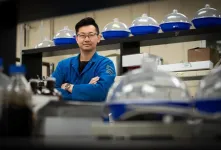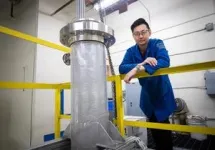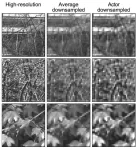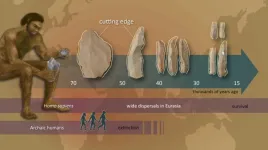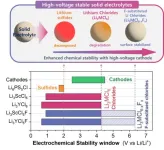(Press-News.org) When it comes to making fuel from plants, the first step has always been the hardest — breaking down the plant matter. A new study finds that introducing a simple, renewable chemical to the pretreatment step can finally make next-generation biofuel production both cost-effective and carbon neutral.
For biofuels to compete with petroleum, biorefinery operations must be designed to better utilize lignin. Lignin is one of the main components of plant cell walls. It provides plants with greater structural integrity and resiliency from microbial attacks. However, these natural properties of lignin also make it difficult to extract and utilize from the plant matter, also known as biomass.
“Lignin utilization is the gateway to making what you want out of biomass in the most economical and environmentally friendly way possible,” said UC Riverside Associate Research Professor Charles Cai. “Designing a process that can better utilize both the lignin and sugars found in biomass is one of the most exciting technical challenges in this field.”
To overcome the lignin hurdle, Cai invented CELF, which stands for co-solvent enhanced lignocellulosic fractionation. It is an innovative biomass pretreatment technology.
“CELF uses tetrahydrofuran or THF to supplement water and dilute acid during biomass pretreatment. It improves overall efficiency and adds lignin extraction capabilities,” Cai said. “Best of all, THF itself can be made from biomass sugars.”
A landmark Energy & Environmental Science paper details the degree to which a CELF biorefinery offers economic and environmental benefits over both petroleum-based fuels and earlier biofuel production methods.
The paper is a collaboration between Cai’s research team at UCR, the Center for Bioenergy Innovation managed by Oak Ridge National Laboratories, and the National Renewable Energy Laboratory, with funding provided by the U.S. Department of Energy’s Office of Science. In it, the researchers consider two main variables: what kind of biomass is most ideal and what to do with the lignin once it’s been extracted.
First-generation biofuel operations use food crops like corn, soy, and sugarcane as raw materials, or feedstocks. Because these feedstocks divert land and water away from food production, using themfor biofuels is not ideal.
Second-generation operations use non-edible plant biomass as feedstocks. An example of biomass feedstocks includes wood residues from milling operations, sugarcane bagasse, or corn stover, all of which are abundant low-cost byproducts of forestry and agricultural operations.
According to the Department of Energy, up to a billion tons per year of biomass could be made available for the manufacture of biofuels and bioproducts in the US alone, capable of displacing 30% of our petroleum consumption while also creating new domestic jobs.
Because a CELF biorefinery can more fully utilize plant matter than earlier second-generation methods, the researchers found that a heavier, denser feedstock like hardwood poplar is preferable over less carbon-dense corn stover for yielding greater economic and environmental benefits.
Using poplar in a CELF biorefinery, the researchers demonstrate that sustainable aviation fuel could be made at a break-even price as low as $3.15 per gallon of gasoline equivalent. The current average cost for a gallon of jet fuel in the U.S. is $5.96.
The U.S. government issues credits for biofuel production in the form of renewable identification number credits, a subsidy meant to bolster domestic biofuel production. The tier of these credits issued for second-generation biofuels, the D3 tier, is typically traded at $1 per gallon or higher. At this price per credit, the paper demonstrates that one can expect a rate of return of over 20% from the operation.
“Spending a little more for a more carbon-rich feedstock like poplar still yields more economic benefits than a cheaper feedstock like corn stover, because you can make more fuel and chemicals from it,” Cai said.
The paper also illustrates how lignin utilization can positively contribute to overall biorefinery economics while keeping the carbon footprint as low as possible. In older biorefinery models, where biomass is cooked in water and acid, the lignin is mostly unusable for more than its heating value.
“The older models would elect to burn the lignin to supplement heat and energy for these biorefineries because they could mostly only leverage the sugars in the biomass - a costly proposition that leaves a lot of value off the table,” said Cai.
In addition to better lignin utilization, the CELF biorefinery model also proposes to produce renewable chemicals. These chemicals could be used as building blocks for bioplastics and food and drink flavoring compounds. These chemicals take up some of the carbon in the plant biomass that would not get released back into the atmosphere as CO2.
“Adding THF helps reduce the energy cost of pretreatment and helps isolate lignin, so you wouldn’t have to burn it anymore. On top of that, we can make renewable chemicals that help us achieve a near-zero global warming potential,” Cai said. “I think this moves the needle from Gen 2 biofuels to Gen 2+.”
In light of the team’s recent successes, the Department of Energy’s Bioenergy Technology Office has awarded the researchers a $2 million grant to build a small-scale CELF pilot plant at UCR. Cai hopes that demonstrating the pilot plant will lead to larger-scale investment in the technology, as harnessing energy from fossil fuels adds to global warming and hurts the planet.
“I began this work more than a decade ago because I wanted to make an impact. I wanted to find a viable alternative to fossil fuels and my colleagues and I have done that,” Cai said. “Using CELF, we have shown it is possible to create cost-effective fuels from biomass and lignin and help curb our contribution of carbon emissions into the atmosphere.”
END
Inexpensive, carbon-neutral biofuels are finally possible
From solvent to solvency
2024-02-07
ELSE PRESS RELEASES FROM THIS DATE:
Will this new solar maximum solve the puzzle of the Sun’s gamma-ray picture?
2024-02-07
The Sun’s polar regions were the most active emitting high energy radiation during the previous solar maximum, an imbalance yet to be explained, and reported for the first time in a study led by a researcher of the Faculty of Sciences of the University of Lisbon (Ciências ULisboa) (Portugal).
The Sun shines brightly in the visible light, but how does it look like at the highest energies of the electromagnetic radiation? The Sun’s picture taken in gamma rays is a deadly sight, luckily blinded by the Earth’s atmosphere and only seen from space. Each photon carries a billion times more energy than its ultraviolet sibling. How does the Sun’s regular gamma rays’ ...
A machine learning framework that encodes images like a retina
2024-02-07
A major challenge to developing better neural prostheses is sensory encoding: transforming information captured from the environment by sensors into neural signals that can be interpreted by the nervous system. But because the number of electrodes in a prosthesis is limited, this environmental input must be reduced in some way, while still preserving the quality of the data that is transmitted to the brain.
Demetri Psaltis (Optics Lab) and Christophe Moser (Laboratory of Applied Photonics Devices) collaborated with Diego Ghezzi of the Hôpital ophtalmique Jules-Gonin – Fondation Asile des Aveugles (previously Medtronic Chair in Neuroengineering at EPFL) to apply machine ...
Innovation in stone tool technology involved multiple stages at the time of modern human dispersals
2024-02-07
A study led by researchers at the Nagoya University Museum in Japan may change how we understand the cultural evolution of Homo sapiens at the time of their dispersal across Eurasia about 50,000 to 40,000 years ago. These findings challenge traditional beliefs about the timing and nature of cultural transitions during this critical period in human history.
Published in Nature Communications, the researchers’ insights into stone tool technology suggest that the commonly held view of a ‘revolution’ in culture and technology that allowed anatomically modern humans to outcompete ...
New study sheds new light on forests' role in climate and water cycle
2024-02-07
Forests, which cover a third of Earth's land surface, are pivotal in carbon storage and the water cycle, though the full scope of their impact remains to be fully understood. In a new study published in Nature Communications, researchers from Stockholm University and international colleagues provide new insights into the complex role forests play in the climate system and water cycle.
The research, involving scientists from 11 institutions across five countries, including Sweden, the UK, Finland, Germany, and Brazil, highlights the intricate relationship between forests, particularly their emission ...
Repetitive high concentration capsaicin patch applications for nerve pain in a real-world setting
2024-02-07
Capsaicin, derived from hot chili pepper plants, has been used to treat various types of pain, and a high concentration capsaicin patch (HCCP) is approved for the treatment of nerve (or neuropathic) pain. In a real-world study published in Pain Practice that included 97 outpatients in Germany diagnosed primarily with neuropathic back pain, postoperative/posttraumatic neuropathic pain, or postherpetic neuralgia (shingles pain), patients appeared to benefit from multiple HCCP applications.
Among the ...
Does gender affect food allergy’s impact on quality of life?
2024-02-07
An analysis of relevant published studies indicates that across all ages, food allergy negatively affects individuals’ quality of life to a greater extent in females than in males.
The analysis, which is published in Clinical and Experimental Allergy, included 34 studies. In the studies, women and the parents of girls tended to report a greater impact of food allergy on health-related quality of life than men or parents of boys.
Evidence also showed that improvements in quality of life over the course of treatment for food allergy can be different for males and females, with weak evidence suggesting that male children may experience more improvements ...
Does air pollution contribute to global cardiovascular disease–related deaths?
2024-02-07
A recent analysis of data from nearly all World Health Organization member states clearly demonstrates a link between air pollution and mortality from cardiovascular diseases, with more of such deaths associated with air pollution in low-income countries compared with high-income countries.
In all 183 countries included in the Chronic Diseases and Translational Medicine study, ischemic heart disease-related deaths attributed to air pollution were higher than stroke-related deaths caused by air pollution. In 2019, outdoor air pollution caused 16 ischemic heart disease-related deaths per 100,000 people in high-income countries compared with 70 per 100,000 in low-income countries.
Also, in ...
Researchers develop and test the first unmanned forestry machine
2024-02-07
A study published in the Journal of Field Robotics assessed the world’s first unmanned machine designed for autonomous forestry operations. Investigators demonstrated that using computer vision, autonomous navigation, and manipulator control algorithms, their newly developed machine can safely, accurately, and efficiently pick up logs from the ground and maneuver through various forest terrains without the need for human intervention.
The research represents a significant milestone in the field of autonomous outdoor robotics, which could reduce the need for human labor, thereby increasing productivity and reducing labor costs, while ...
KIST-LLNL raises expectations for commercialization of high-energy-density all-solid-state batteries
2024-02-07
Researchers are actively working on non-flammable solid electrolytes as a safer alternative to liquid electrolytes commonly found in lithium-ion batteries, which are vulnerable to fires and explosions. While sulfide-based solid electrolytes exhibit excellent ionic conductivity, their chemical instability with high-voltage cathode materials necessary for high-energy-density batteries has impeded their commercial viability. Consequently, there has been a growing interest in chloride-based solid electrolytes, which are stability in high-voltage conditions due to their strong bonding ...
Survey finds most don’t know the numbers that help predict heart disease
2024-02-07
COLUMBUS, Ohio – Keeping track of blood pressure, cholesterol and blood sugar levels can help identify risk factors for heart disease. However, a national survey by The Ohio State University Wexner Medical Center found that while many adults know their childhood address or best friend’s birthday, less than half know their blood pressure or ideal weight, and fewer than 1 in 5 know their cholesterol or blood sugar levels.
“Recognizing heart disease risk factors early and adequately treating ...
LAST 30 PRESS RELEASES:
Making lighter work of calculating fluid and heat flow
Normalizing blood sugar can halve heart attack risk
Lowering blood sugar cuts heart attack risk in people with prediabetes
Study links genetic variants to risk of blinding eye disease in premature infants
Non-opioid ‘pain sponge’ therapy halts cartilage degeneration and relieves chronic pain
AI can pick up cultural values by mimicking how kids learn
China’s ecological redlines offer fast track to 30 x 30 global conservation goal
Invisible indoor threats: emerging household contaminants and their growing risks to human health
Adding antibody treatment to chemo boosts outcomes for children with rare cancer
Germline pathogenic variants among women without a history of breast cancer
Tanning beds triple melanoma risk, potentially causing broad DNA damage
Unique bond identified as key to viral infection speed
Indoor tanning makes youthful skin much older on a genetic level
Mouse model sheds new light on the causes and potential solutions to human GI problems linked to muscular dystrophy
The Journal of Nuclear Medicine ahead-of-print tip sheet: December 12, 2025
Smarter tools for peering into the microscopic world
Applications open for funding to conduct research in the Kinsey Institute archives
Global measure underestimates the severity of food insecurity
Child survivors of critical illness are missing out on timely follow up care
Risk-based vs annual breast cancer screening / the WISDOM randomized clinical trial
University of Toronto launches Electric Vehicle Innovation Ontario to accelerate advanced EV technologies and build Canada’s innovation advantage
Early relapse predicts poor outcomes in aggressive blood cancer
American College of Lifestyle Medicine applauds two CMS models aligned with lifestyle medicine practice and reimbursement
Clinical trial finds cannabis use not a barrier to quitting nicotine vaping
Supplemental nutrition assistance program policies and food insecurity
Switching immune cells to “night mode” could limit damage after a heart attack, study suggests
URI-based Global RIghts Project report spotlights continued troubling trends in worldwide inhumane treatment
Neutrophils are less aggressive at night, explaining why nighttime heart attacks cause less damage than daytime events
Menopausal hormone therapy may not pose breast cancer risk for women with BRCA mutations
Mobile health tool may improve quality of life for adolescent and young adult breast cancer survivors
[Press-News.org] Inexpensive, carbon-neutral biofuels are finally possibleFrom solvent to solvency
